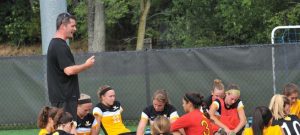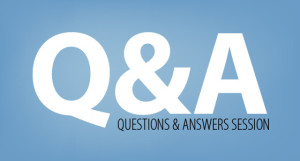Podcast: Play in new window | Download
Subscribe: Apple Podcasts | RSS
 I was watching the US Open Cup game last night with Sporting KC vs San Jose. The game went to PK’s and it got me thinking about the differences between youth and adult PKs.
I was watching the US Open Cup game last night with Sporting KC vs San Jose. The game went to PK’s and it got me thinking about the differences between youth and adult PKs.
The goalkeepers are usually much smaller in relation to the goal so the things that will work for young players will not be effective for professions. I tell my youth players to keep the ball on the ground and aim for one side of the goalkeeper or the other. They don’t need to put it in the corner because a strong pass to one side or another is usually enough to beat most youth goalkeepers.
At the professional level the keeper obviously have a much greater ability to cover the entire goal. That’s why you see a great number of penalty kicks taken high and hard. Adult keepers can get to the lower corners and often that’s where they guess so a kick that is higher and harder is more likely to be successful.
I’m going to talk about overtime and ways to decide games more next week because a recent article on PK’s and this shootout really got me thinking about it.

This week’s question is from Robert.
He’s asking about the use of cones in training.
Robert says,
“Talking in general terms: we use cones to mark out places we want our players to stand at trainings – but then we want them to find spaces at game day.
I’m thinking of adapting as many of my sessions to be “in between” the cones, for things like pass and follow drills. Shooting would change from “start at this cone, – dribble to that cone, then shoot.” And become more like ” taking a touch away from the nearest cone, dribble between two cones, then shoot”
Is there information on this mentality? Most of the books and Internet trainings have cones for players to start and finish at.”
Thanks for the question Robert!
I agree that the cones can become a crutch that limits our player’s understand and ability to transfer what they’ve learned in training to matchday. I also think they are necessary in the initial phase of learning to give the players a reference point.
I start to remove them or change the point of reference as soon as I can. For example. When we’re playing rondo games I want the players on the sides and not in the corners. This gives them more space to move and support their teammates and also makes the point that they shouldn’t be standing in one place.
Whenever I can I use the cones as defenders for the players to move away from rather than a starting point. Even the cones used in the Cogi patterns I’ve talked so much about can be through of this way because the players are always using the farthest foot away from them or opening up to the outside of them.
Here’s a link to a activity I did that’s focused on opening up to receive the ball. The players move to the space between the cones rather than to a cone itself.
In This Episode
I truly believe that the vast majority of coaches want to do what is best for their player’s long term development. They start the season with a plan sometimes written out in detail and other times it’s more of a general idea of how they want to proceed.
At some point during the season many start to make little compromises that will help their team be successful in the short term even though they may not be to the player’s long term benefit.
Today I’ll look at the internal and external forces impact a coach’s decision to go for a quick fix rather than stick to their long term plan.
Here are the links to the articles I mentioned:
http://goalnation.com/youth-soccer-coaches-must-courage-patient/
http://www.ussoccer.com/stories/2014/03/17/13/07/pia-sundhage-finding-the-balance
Future Episodes
Next week I’m going to look at the different methods that have been used over the years to decide games that are tied after regulation and some new ideas that are being proposed to make overtime and PK’s fairer.

Another great podcast! So I was told by a club that I wasn’t going to be able to coach a team at the U9 level because I didn’t have a winning mentality. So at the level what that says to me is now winning is the most important thing. I’d had these 2 teams from U6. So to have that sprung on me right before tryouts was tough. I thought back to my time with the kids and ask some questions of myself as a coach. The hardest part for me was to watch them lose even though I knew the were developing. We would play teams that only play their best players. One coach we played against wouldn’t play their own kid just so they could win. It’s no easy to see your kids discouraged. Because the hardest thing to teach is confidence. Winning makes every player confident losing not so much. You have to build up your players and challenge them at the same time. Let them know there are expectations and at the same time keeping them on your side. The best way I knew how was to let them know that my goals are their goals. That my job was to help the achieve what they wanted. So we they went to another coach at U9 my 2 teams weren’t that far apart. Both played in the top division and both finished in the top 3 I believe. A few months after that the coach that took over emailed me saying how impressed he was with the kids how well they played. Most of it was the kids but I’d like to think I helped. At the very least I hope that I encourage them and gave them the confidence to be patient and develop
Very good information in this podcast. I did not see the links you referenced at the end of the podcast in the show notes. Please direct me to where they can be found.
Sorry about that! I’ve added them to the web page.
I noticed the games after I didn’t use cones but instead coaching sticks, my girls played much better. I think just the fact that there was something physical they needed to move around and not hit, because, well, hitting a coaching stick (or a homemade one like I have) gives much different feedback then hitting a flat or small cone. I’ve started, when appropriate, replacing cones with coaching sticks to give this specific type of feedback to my girls. For example, instead of semi-large cones to use for turning or receiving on the outside/wide, I’ve used training sticks.